+ Open data
Open data
- Basic information
Basic information
| Entry | Database: PDB / ID: 1s1q | ||||||
|---|---|---|---|---|---|---|---|
| Title | TSG101(UEV) domain in complex with Ubiquitin | ||||||
 Components Components |
| ||||||
 Keywords Keywords |  TRANSLATION / TRANSLATION /  PROTEIN TURNOVER / PROTEIN TURNOVER /  heterodimer heterodimer | ||||||
| Function / homology |  Function and homology information Function and homology informationpositive regulation of viral budding via host ESCRT complex / positive regulation of ubiquitin-dependent endocytosis / extracellular transport /  ESCRT I complex / negative regulation of epidermal growth factor-activated receptor activity / regulation of extracellular exosome assembly / ESCRT I complex / negative regulation of epidermal growth factor-activated receptor activity / regulation of extracellular exosome assembly /  viral budding / viral budding /  regulation of MAP kinase activity / exosomal secretion / : ...positive regulation of viral budding via host ESCRT complex / positive regulation of ubiquitin-dependent endocytosis / extracellular transport / regulation of MAP kinase activity / exosomal secretion / : ...positive regulation of viral budding via host ESCRT complex / positive regulation of ubiquitin-dependent endocytosis / extracellular transport /  ESCRT I complex / negative regulation of epidermal growth factor-activated receptor activity / regulation of extracellular exosome assembly / ESCRT I complex / negative regulation of epidermal growth factor-activated receptor activity / regulation of extracellular exosome assembly /  viral budding / viral budding /  regulation of MAP kinase activity / exosomal secretion / : / : / protein transport to vacuole involved in ubiquitin-dependent protein catabolic process via the multivesicular body sorting pathway / protein modification process => GO:0036211 / membrane fission / positive regulation of exosomal secretion / ubiquitin-dependent protein catabolic process via the multivesicular body sorting pathway / regulation of MAP kinase activity / exosomal secretion / : / : / protein transport to vacuole involved in ubiquitin-dependent protein catabolic process via the multivesicular body sorting pathway / protein modification process => GO:0036211 / membrane fission / positive regulation of exosomal secretion / ubiquitin-dependent protein catabolic process via the multivesicular body sorting pathway /  multivesicular body assembly / Flemming body / multivesicular body assembly / Flemming body /  virion binding / endosome to lysosome transport / negative regulation of epidermal growth factor receptor signaling pathway / viral budding via host ESCRT complex / Peptide chain elongation / autophagosome maturation / Selenocysteine synthesis / Formation of a pool of free 40S subunits / Eukaryotic Translation Termination / Response of EIF2AK4 (GCN2) to amino acid deficiency / SRP-dependent cotranslational protein targeting to membrane / Viral mRNA Translation / Nonsense Mediated Decay (NMD) independent of the Exon Junction Complex (EJC) / GTP hydrolysis and joining of the 60S ribosomal subunit / L13a-mediated translational silencing of Ceruloplasmin expression / Major pathway of rRNA processing in the nucleolus and cytosol / viral release from host cell / Nonsense Mediated Decay (NMD) enhanced by the Exon Junction Complex (EJC) / Maturation of protein E / Maturation of protein E / keratinocyte differentiation / ER Quality Control Compartment (ERQC) / Myoclonic epilepsy of Lafora / FLT3 signaling by CBL mutants / Prevention of phagosomal-lysosomal fusion / IRAK2 mediated activation of TAK1 complex / Alpha-protein kinase 1 signaling pathway / virion binding / endosome to lysosome transport / negative regulation of epidermal growth factor receptor signaling pathway / viral budding via host ESCRT complex / Peptide chain elongation / autophagosome maturation / Selenocysteine synthesis / Formation of a pool of free 40S subunits / Eukaryotic Translation Termination / Response of EIF2AK4 (GCN2) to amino acid deficiency / SRP-dependent cotranslational protein targeting to membrane / Viral mRNA Translation / Nonsense Mediated Decay (NMD) independent of the Exon Junction Complex (EJC) / GTP hydrolysis and joining of the 60S ribosomal subunit / L13a-mediated translational silencing of Ceruloplasmin expression / Major pathway of rRNA processing in the nucleolus and cytosol / viral release from host cell / Nonsense Mediated Decay (NMD) enhanced by the Exon Junction Complex (EJC) / Maturation of protein E / Maturation of protein E / keratinocyte differentiation / ER Quality Control Compartment (ERQC) / Myoclonic epilepsy of Lafora / FLT3 signaling by CBL mutants / Prevention of phagosomal-lysosomal fusion / IRAK2 mediated activation of TAK1 complex / Alpha-protein kinase 1 signaling pathway /  Glycogen synthesis / IRAK1 recruits IKK complex / IRAK1 recruits IKK complex upon TLR7/8 or 9 stimulation / Membrane binding and targetting of GAG proteins / Constitutive Signaling by NOTCH1 HD Domain Mutants / NOTCH2 Activation and Transmission of Signal to the Nucleus / Endosomal Sorting Complex Required For Transport (ESCRT) / IRAK2 mediated activation of TAK1 complex upon TLR7/8 or 9 stimulation / Regulation of FZD by ubiquitination / PTK6 Regulates RTKs and Their Effectors AKT1 and DOK1 / Negative regulation of FLT3 / TICAM1,TRAF6-dependent induction of TAK1 complex / TICAM1-dependent activation of IRF3/IRF7 / APC/C:Cdc20 mediated degradation of Cyclin B / Downregulation of ERBB4 signaling / p75NTR recruits signalling complexes / TRAF6 mediated IRF7 activation in TLR7/8 or 9 signaling / APC-Cdc20 mediated degradation of Nek2A / PINK1-PRKN Mediated Mitophagy / TRAF6-mediated induction of TAK1 complex within TLR4 complex / InlA-mediated entry of Listeria monocytogenes into host cells / Pexophagy / Regulation of innate immune responses to cytosolic DNA / VLDLR internalisation and degradation / Downregulation of ERBB2:ERBB3 signaling / NRIF signals cell death from the nucleus / Activated NOTCH1 Transmits Signal to the Nucleus / Translesion synthesis by REV1 / NF-kB is activated and signals survival / Regulation of PTEN localization / Translesion synthesis by POLK / Glycogen synthesis / IRAK1 recruits IKK complex / IRAK1 recruits IKK complex upon TLR7/8 or 9 stimulation / Membrane binding and targetting of GAG proteins / Constitutive Signaling by NOTCH1 HD Domain Mutants / NOTCH2 Activation and Transmission of Signal to the Nucleus / Endosomal Sorting Complex Required For Transport (ESCRT) / IRAK2 mediated activation of TAK1 complex upon TLR7/8 or 9 stimulation / Regulation of FZD by ubiquitination / PTK6 Regulates RTKs and Their Effectors AKT1 and DOK1 / Negative regulation of FLT3 / TICAM1,TRAF6-dependent induction of TAK1 complex / TICAM1-dependent activation of IRF3/IRF7 / APC/C:Cdc20 mediated degradation of Cyclin B / Downregulation of ERBB4 signaling / p75NTR recruits signalling complexes / TRAF6 mediated IRF7 activation in TLR7/8 or 9 signaling / APC-Cdc20 mediated degradation of Nek2A / PINK1-PRKN Mediated Mitophagy / TRAF6-mediated induction of TAK1 complex within TLR4 complex / InlA-mediated entry of Listeria monocytogenes into host cells / Pexophagy / Regulation of innate immune responses to cytosolic DNA / VLDLR internalisation and degradation / Downregulation of ERBB2:ERBB3 signaling / NRIF signals cell death from the nucleus / Activated NOTCH1 Transmits Signal to the Nucleus / Translesion synthesis by REV1 / NF-kB is activated and signals survival / Regulation of PTEN localization / Translesion synthesis by POLK /  Regulation of BACH1 activity / Synthesis of active ubiquitin: roles of E1 and E2 enzymes / Regulation of BACH1 activity / Synthesis of active ubiquitin: roles of E1 and E2 enzymes /  multivesicular body / Translesion synthesis by POLI / Gap-filling DNA repair synthesis and ligation in GG-NER / MAP3K8 (TPL2)-dependent MAPK1/3 activation / TICAM1, RIP1-mediated IKK complex recruitment / Downregulation of TGF-beta receptor signaling / cytosolic ribosome / Josephin domain DUBs / Activation of IRF3, IRF7 mediated by TBK1, IKKε (IKBKE) / Regulation of activated PAK-2p34 by proteasome mediated degradation / InlB-mediated entry of Listeria monocytogenes into host cell / IKK complex recruitment mediated by RIP1 / JNK (c-Jun kinases) phosphorylation and activation mediated by activated human TAK1 / TGF-beta receptor signaling in EMT (epithelial to mesenchymal transition) / HCMV Late Events / N-glycan trimming in the ER and Calnexin/Calreticulin cycle / Autodegradation of Cdh1 by Cdh1:APC/C / TNFR1-induced NF-kappa-B signaling pathway / multivesicular body / Translesion synthesis by POLI / Gap-filling DNA repair synthesis and ligation in GG-NER / MAP3K8 (TPL2)-dependent MAPK1/3 activation / TICAM1, RIP1-mediated IKK complex recruitment / Downregulation of TGF-beta receptor signaling / cytosolic ribosome / Josephin domain DUBs / Activation of IRF3, IRF7 mediated by TBK1, IKKε (IKBKE) / Regulation of activated PAK-2p34 by proteasome mediated degradation / InlB-mediated entry of Listeria monocytogenes into host cell / IKK complex recruitment mediated by RIP1 / JNK (c-Jun kinases) phosphorylation and activation mediated by activated human TAK1 / TGF-beta receptor signaling in EMT (epithelial to mesenchymal transition) / HCMV Late Events / N-glycan trimming in the ER and Calnexin/Calreticulin cycle / Autodegradation of Cdh1 by Cdh1:APC/C / TNFR1-induced NF-kappa-B signaling pathway /  ubiquitin binding / APC/C:Cdc20 mediated degradation of Securin / Asymmetric localization of PCP proteins / TCF dependent signaling in response to WNT ubiquitin binding / APC/C:Cdc20 mediated degradation of Securin / Asymmetric localization of PCP proteins / TCF dependent signaling in response to WNTSimilarity search - Function | ||||||
| Biological species |   Homo sapiens (human) Homo sapiens (human) | ||||||
| Method |  X-RAY DIFFRACTION / X-RAY DIFFRACTION /  SYNCHROTRON / SYNCHROTRON /  SAD, SAD,  Molecular replacement / Resolution: 2 Å Molecular replacement / Resolution: 2 Å | ||||||
 Authors Authors | Sundquist, W.I. / Schubert, H.L. / Kelly, B.N. / Hill, G.C. / Holton, J.M. / Hill, C.P. | ||||||
 Citation Citation |  Journal: Mol.Cell / Year: 2004 Journal: Mol.Cell / Year: 2004Title: Ubiquitin recognition by the human TSG101 protein Authors: Sundquist, W.I. / Schubert, H.L. / Kelly, B.N. / Hill, G.C. / Holton, J.M. / Hill, C.P. | ||||||
| History |
|
- Structure visualization
Structure visualization
| Structure viewer | Molecule:  Molmil Molmil Jmol/JSmol Jmol/JSmol |
|---|
- Downloads & links
Downloads & links
- Download
Download
| PDBx/mmCIF format |  1s1q.cif.gz 1s1q.cif.gz | 109 KB | Display |  PDBx/mmCIF format PDBx/mmCIF format |
|---|---|---|---|---|
| PDB format |  pdb1s1q.ent.gz pdb1s1q.ent.gz | 83.7 KB | Display |  PDB format PDB format |
| PDBx/mmJSON format |  1s1q.json.gz 1s1q.json.gz | Tree view |  PDBx/mmJSON format PDBx/mmJSON format | |
| Others |  Other downloads Other downloads |
-Validation report
| Arichive directory |  https://data.pdbj.org/pub/pdb/validation_reports/s1/1s1q https://data.pdbj.org/pub/pdb/validation_reports/s1/1s1q ftp://data.pdbj.org/pub/pdb/validation_reports/s1/1s1q ftp://data.pdbj.org/pub/pdb/validation_reports/s1/1s1q | HTTPS FTP |
|---|
-Related structure data
- Links
Links
- Assembly
Assembly
| Deposited unit | 
| ||||||||||
|---|---|---|---|---|---|---|---|---|---|---|---|
| 1 | 
| ||||||||||
| 2 | 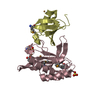
| ||||||||||
| Unit cell |
| ||||||||||
| Details | The biological heterodimer is formed from molecules AB or CD. Two dimers in the ASU. |
- Components
Components
-Protein , 2 types, 4 molecules ACBD
| #1: Protein |  TSG101 / TSG101(UEV) / tumor susceptibility protein TSG101 / TSG101(UEV) / tumor susceptibility proteinMass: 16867.828 Da / Num. of mol.: 2 / Fragment: TSG101(UEV) domain Source method: isolated from a genetically manipulated source Source: (gene. exp.)   Homo sapiens (human) / Production host: Homo sapiens (human) / Production host:   Escherichia coli (E. coli) / References: UniProt: Q99816 Escherichia coli (E. coli) / References: UniProt: Q99816#2: Protein |  / ubiquitin and ribosomal protein S27a precursor / ubiquitin carboxyl extension protein 80 / 40S ...ubiquitin and ribosomal protein S27a precursor / ubiquitin carboxyl extension protein 80 / 40S ribosomal protein S27a / ubiquitin-CEP80 / HUBCEP80 / ubiquitin and ribosomal protein S27a precursor / ubiquitin carboxyl extension protein 80 / 40S ...ubiquitin and ribosomal protein S27a precursor / ubiquitin carboxyl extension protein 80 / 40S ribosomal protein S27a / ubiquitin-CEP80 / HUBCEP80Mass: 8623.726 Da / Num. of mol.: 2 Source method: isolated from a genetically manipulated source Source: (gene. exp.)   Homo sapiens (human) / Production host: Homo sapiens (human) / Production host:   Escherichia coli (E. coli) / References: UniProt: P62988, UniProt: P0CG48*PLUS Escherichia coli (E. coli) / References: UniProt: P62988, UniProt: P0CG48*PLUS |
|---|
-Non-polymers , 4 types, 360 molecules 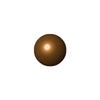

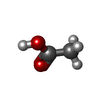




| #3: Chemical | ChemComp-CU /  Copper Copper#4: Chemical | ChemComp-SO4 /  Sulfate Sulfate#5: Chemical |  Acetic acid Acetic acid#6: Water | ChemComp-HOH / |  Water Water |
|---|
-Experimental details
-Experiment
| Experiment | Method:  X-RAY DIFFRACTION / Number of used crystals: 1 X-RAY DIFFRACTION / Number of used crystals: 1 |
|---|
- Sample preparation
Sample preparation
| Crystal | Density Matthews: 2.91 Å3/Da / Density % sol: 57.4 % |
|---|---|
Crystal grow | Temperature: 298 K / Method: vapor diffusion, sitting drop / pH: 4.6 Details: 1.4M Ammonium sulfate, 0.1M sodium acetate, pH 4.6, VAPOR DIFFUSION, SITTING DROP, temperature 298K |
-Data collection
| Diffraction | Mean temperature: 100 K |
|---|---|
| Diffraction source | Source:  SYNCHROTRON / Site: SYNCHROTRON / Site:  ALS ALS  / Beamline: 8.3.1 / Wavelength: 0.97979 Å / Beamline: 8.3.1 / Wavelength: 0.97979 Å |
| Detector | Type: ADSC QUANTUM 4 / Detector: CCD / Date: Jan 10, 2003 |
| Radiation | Monochromator: Double crystal / Protocol: SINGLE WAVELENGTH / Monochromatic (M) / Laue (L): M / Scattering type: x-ray |
| Radiation wavelength | Wavelength : 0.97979 Å / Relative weight: 1 : 0.97979 Å / Relative weight: 1 |
| Reflection | Resolution: 2→72.55 Å / Num. all: 41841 / Num. obs: 40921 / % possible obs: 97.8 % / Observed criterion σ(I): 2 |
| Reflection shell | Resolution: 2→2.1 Å / Rmerge(I) obs: 0.335 / Mean I/σ(I) obs: 2.1 / % possible all: 96.2 |
- Processing
Processing
| Software |
| |||||||||||||||||||||||||||||||||||||||||||||||||||||||||||||||||||||||||||||||||||||||||||||||||||||||||
|---|---|---|---|---|---|---|---|---|---|---|---|---|---|---|---|---|---|---|---|---|---|---|---|---|---|---|---|---|---|---|---|---|---|---|---|---|---|---|---|---|---|---|---|---|---|---|---|---|---|---|---|---|---|---|---|---|---|---|---|---|---|---|---|---|---|---|---|---|---|---|---|---|---|---|---|---|---|---|---|---|---|---|---|---|---|---|---|---|---|---|---|---|---|---|---|---|---|---|---|---|---|---|---|---|---|---|
| Refinement | Method to determine structure : :  SAD, SAD,  Molecular replacement Molecular replacementStarting model: 1KPP & 1UBO Resolution: 2→72.55 Å / Cor.coef. Fo:Fc: 0.951 / Cor.coef. Fo:Fc free: 0.932 / SU B: 4.295 / SU ML: 0.118 / Cross valid method: THROUGHOUT / σ(F): 0 / ESU R: 0.166 / ESU R Free: 0.154 / Stereochemistry target values: Engh & Huber
| |||||||||||||||||||||||||||||||||||||||||||||||||||||||||||||||||||||||||||||||||||||||||||||||||||||||||
| Solvent computation | Ion probe radii: 0.8 Å / Shrinkage radii: 0.8 Å / VDW probe radii: 1.4 Å / Solvent model: BABINET MODEL WITH MASK | |||||||||||||||||||||||||||||||||||||||||||||||||||||||||||||||||||||||||||||||||||||||||||||||||||||||||
| Displacement parameters | Biso mean: 27.29 Å2
| |||||||||||||||||||||||||||||||||||||||||||||||||||||||||||||||||||||||||||||||||||||||||||||||||||||||||
| Refinement step | Cycle: LAST / Resolution: 2→72.55 Å
| |||||||||||||||||||||||||||||||||||||||||||||||||||||||||||||||||||||||||||||||||||||||||||||||||||||||||
| Refine LS restraints |
| |||||||||||||||||||||||||||||||||||||||||||||||||||||||||||||||||||||||||||||||||||||||||||||||||||||||||
| LS refinement shell | Resolution: 2→2.052 Å / Total num. of bins used: 20 /
|
 Movie
Movie Controller
Controller




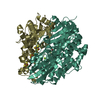
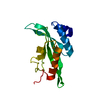
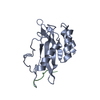

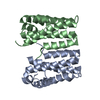

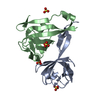
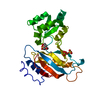


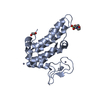

 PDBj
PDBj





























